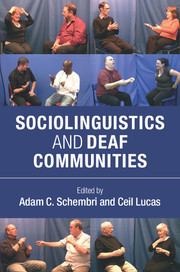Book contents
- Frontmatter
- Contents
- List of Figures
- List of Tables
- Notes on Contributors
- 1 Introduction
- 2 Sign languages in the world
- 3 Sign languages in contact
- 4 Variation and change in sign languages
- 5 Discourse analysis and sign languages
- 6 Language policy and planning in Deaf communities
- 7 Language attitudes in Deaf communities
- Index
- References
3 - Sign languages in contact
Published online by Cambridge University Press: 05 February 2015
- Frontmatter
- Contents
- List of Figures
- List of Tables
- Notes on Contributors
- 1 Introduction
- 2 Sign languages in the world
- 3 Sign languages in contact
- 4 Variation and change in sign languages
- 5 Discourse analysis and sign languages
- 6 Language policy and planning in Deaf communities
- 7 Language attitudes in Deaf communities
- Index
- References
Summary
Introduction
In some regions of the world, the regular use of more than one language within a single geographical area is commonplace in everyday life. This is true from the hills and valleys of the American Southwest, where English and Spanish can be heard in everyday conversations in restaurants, shopping areas, and other public places, to the campus of Gallaudet University in Washington, DC, where American Sign Language (ASL), English, and other signed and spoken languages pepper the auditory and visual landscape of that historical institution. Evidence of language contact can be found in everyday conversations (e.g., with bits of one language surfacing in the other) and also in various linguistic features of languages that have been in sustained contact over a period of time (e.g., fully integrated words that originated in another language). One can find features of an ambient spoken or written language within a signed language just as one can find words, sounds, and grammatical constructions from one spoken language within another. Language contact is part of the evolutionary history of languages in the world, and in this chapter we focus on various aspects of contact that surface when considering communities of language users that are bilingual and bimodal (i.e., they use languages that are perceived either visually, auditorally, or both).
Language contact is the norm in Deaf communities, and Deaf people are typically multilingual and multicultural (e.g., see Grosjean 2010; Plaza-Pust and Morales-López 2008 for detailed discussions). They use signed, written, and, in some cases, spoken languages for daily communication, which means that aspects of the spoken and/or written languages of the larger communities are in constant interaction with the signed languages. In some cases, the contact has resulted in spoken language structures that have become incorporated into the sign languages – having been modified over time to conform to the linguistic processes of a sign language. In other cases, the contact may not be influencing structural changes to either language. Interestingly, language contact processes are at work whether interaction occurs between deaf and hearing signers or solely among deaf signers, and they have played a very important role in the creation and evolution of signed languages.
- Type
- Chapter
- Information
- Sociolinguistics and Deaf Communities , pp. 29 - 60Publisher: Cambridge University PressPrint publication year: 2015
References
- 19
- Cited by

